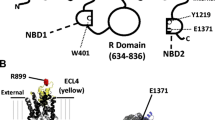Abstract.
The cystic fibrosis transmembrane conductance regulator (CFTR) plays a significant role in transepithelial salt absorption as well as secretion by a number of epithelial tissues including sweat glands, airways and intestine. Early studies suggested that in absorption significant cross talk occurs between CFTR Cl– channels and epithelial Na+ channels (ENaC). Studies based primarily on cultured cells of the airways and on ex vivo expression systems suggested that activating CFTR inhibits ENaC channels so that activation of CFTR and deactivation of ENaC seem reciprocal. Lack of CFTR Cl– conductance (g CFTR) in the plasma membranes was seen to enhance ENaC conductance (g ENaC) and Na+ absorption from the airway surface liquid causing airway pathology in cystic fibrosis (CF). To determine if these events hold true for a purely absorptive epithelium, we investigated the role of CFTR in regulating g ENaC in native human sweat gland ducts. After permeabilizing the basilateral membrane of the duct with α-toxin, the relative activities of ENaC and CFTR in the apical membrane were characterized by correlating the effect of activating CFTR with ENaC function. We found that in contrast to reciprocal activities, activating g CFTR by either cAMP, cGMP or the G-proteins plus 5 mM ATP was accompanied by a concomitant activation, not inhibition, of g ENaC. The activation of g ENaC appeared to be critically dependent on CFTR Cl– channel function because removal of Cl– from the medium, blockage of CFTR with inhibitor DIDS or the absence of CFTR in the ΔF508 CF ducts prevented activation of g ENaC by cAMP, GMP or G-proteins. Most significantly, g ENaC was dramatically reduced, not increased, in CF as compared to non-CF sweat ducts. These results showed that lack of CFTR in the plasma membranes is not characteristically coupled to elevated ENaC activity or to increased Na+ absorption in CF epithelial cells. Not only are CFTR and ENaC activated together in duct salt absorption, but ENaC activation depends on functioning CFTR. NaCl is poorly absorbed in the CF duct because CFTR activity appears to impose a loss of ENaC activity as well.
Similar content being viewed by others
Author information
Authors and Affiliations
Additional information
Electronic Publication
An erratum to this article is available at http://dx.doi.org/10.1007/s00424-006-0182-2.
Rights and permissions
About this article
Cite this article
Reddy, .M., Quinton, .P. Functional interaction of CFTR and ENaC in sweat glands. Pflugers Arch - Eur J Physiol 445, 499–503 (2003). https://doi.org/10.1007/s00424-002-0959-x
Received:
Accepted:
Issue Date:
DOI: https://doi.org/10.1007/s00424-002-0959-x




